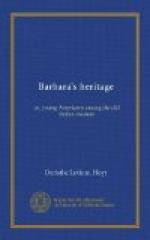The drive was thoroughly delightful. Bologna possesses many individual characteristics. The very narrow streets, the lofty arcades that stretch along on either side of them, the many venerable churches and palaces, the quaintly picturesque towers, kept them exclaiming with pleasure.
“Can we not walk to the Academy?” asked Margery, the next morning. “I do so wish to walk through some of these dear arcades.”
So Barbara drove with Mrs. Douglas, and the others walked right through the heart of the old city, whose streets have echoed to the footfalls of countless and diverse people through a number of centuries that sounds appalling to American ears.
Arrived at the picture-gallery, Mr. Sumner told them that though not of very great importance when compared with many which they had visited, it yet is very interesting on account of its collection of the works of the most noted seventeenth-century Italian painters; especially those belonging to the Bolognese-eclectic school, which was founded by the Carracci.
“Nowhere else can these men, the Carracci, be studied as here in Bologna, where they founded their art-school just at the close of the sixteenth century. There are also some very good examples of the work of Domenichino, Guido Reni, Albani, and other famous pupils of the Carracci. You saw fine frescoes by Domenichino and Guido Reni in Rome and Naples, and I am sure you remember perfectly Domenichino’s Communion of St. Jerome in the Vatican Gallery.
“Perhaps,” he continued, with an inquiring look, “you know the principle on which this school of painting was founded, and which gave it its name.”
Bettina answered: “I think they tried to select the best pictures from all other schools and embody them in their own pictures. I do not think,” she added, with something of a deprecatory look, “that it can be called a very original style.”
“Few styles of painting after the earliest masters can be called original, can they?” replied Mr. Sumner, with a smile. “One great lack of the human race is a spirit of originality. We all go to those who have thought and wrought before us, and hash and rehash their material. But few tell what they are doing so plainly as did the Carracci. The one great want in their painting is that of any definite end or aim.”
“Whom do you call the greatest painters of the school, uncle?” asked Malcom, as they entered a large hall opening from the corridor in which they had been standing.
“Guido Reni and Domenichino merit that honor, I think. Domenichino died young, but painted some excellent pictures, notably the St. Jerome. Guido Reni lived long enough to outlive his good painting, but among his early works are some that may really be called the masterpieces of this school; such as the Aurora and the St. Michael which you saw in Rome.”
“What do you mean by his outliving his good painting?” asked Margery.




